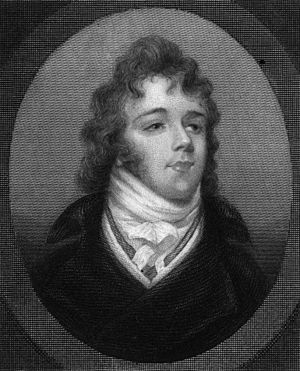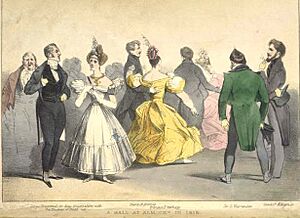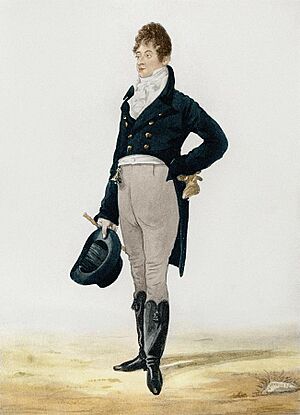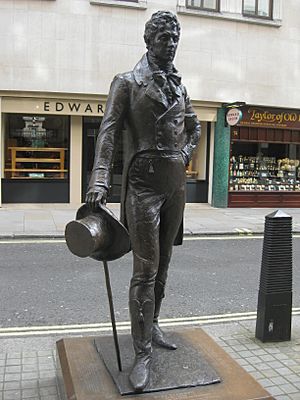Beau Brummell facts for kids
Quick facts for kids
Beau Brummell
|
|
|---|---|

Brummell, engraved from a miniature portrait
|
|
| Born |
George Bryan Brummell
7 June 1778 |
| Died | 30 March 1840 (aged 61) |
| Nationality | British |
| Education | Eton College |
| Alma mater | Oriel College, Oxford |
George Bryan "Beau" Brummell (born June 7, 1778 – died March 30, 1840) was a very important person in Regency England. For many years, he was the top expert on men's fashion. He was once a close friend of the Prince Regent, who later became King George IV.
But after they had a big argument and Brummell got into a lot of debt, he had to move to France. He eventually died in Caen, France, looking very poor and suffering from mental illness.
Brummell is remembered as the best example of a dandy. A dandy is someone who cares a lot about how they look and dress. Many stories and witty sayings about him became famous and are still known today. His name is still linked with style and looking good. It has even been used for many modern products to show they are high quality.
Contents
Brummell's Early Life and Education
Brummell was born in London. His father, William Brummell, was a successful businessman who later worked for the Prime Minister. The family was middle class, but William wanted his son George to become a gentleman. George was raised with this goal in mind.
He went to Eton College, a famous school. There, he quickly made a name for himself in fashion. He updated the white "stock" or cravat that Eton boys wore. He even added a gold buckle to it, making it more stylish.
After Eton, he went to Oxford University. He only stayed for one year, leaving when he was sixteen. While there, he influenced fashion by making cotton stockings and dull cravats unpopular.
Brummell's Time in the Military
In June 1794, Brummell joined the 10th Royal Hussars, a military regiment. He started as a cornet, which was the lowest rank for an officer. Soon after, his nose was broken when a horse kicked him.
His father died in 1795, and Brummell inherited about £30,000. This was a lot of money, but it wasn't enough for an officer in the Prince of Wales's own regiment. Even as a junior officer, Brummell quickly impressed the Prince.
The Prince, known as "the first gentleman of England," was fascinated by Brummell's strong personality. Brummell was allowed to skip duties and do mostly as he pleased. Within three years, by 1796, he was promoted to captain. This made older officers very jealous. In 1797, his regiment moved from London to Manchester. Brummell immediately quit his job. He said Manchester had a bad reputation and lacked culture.
Brummell's Influence in London Society
Even after leaving the military, Brummell remained friends with the Prince. He became a very famous person in fashion. He preferred simple but perfectly fitted clothes instead of overly fancy ones. His everyday style was like other gentlemen of his time. He wore dark coats and long trousers, not knee breeches.
Most importantly, Brummell loved perfectly clean shirt linen and a fancy knotted cravat. This way of wearing a cravat was seen as his biggest fashion idea.
Brummell lived in a house in Mayfair, a fancy part of London. For a while, he avoided the expensive parties and gambling common in high society. But he never saved money on his clothes. When asked how much it would cost to dress one man, he supposedly said, "Why, with tolerable economy, I think it might be done with £800." At that time, a skilled worker earned about £52 a year. He also claimed it took him five hours to get dressed each day. He even suggested polishing boots with champagne! This focus on clothes and a relaxed, witty attitude was called dandyism.
Brummell made clothes look good by matching shapes and contrasting colors. Other important men would ask for his advice on their outfits.
The Duke of Bedford once asked Brummell about his coat. Brummell looked at the Duke with a cool, slightly rude stare. He turned him around, looked closely, and then, holding the coat's lapel, he said with pity, "Bedford, do you call this thing a coat?"
Brummell also had very neat habits. He cleaned his teeth carefully, shaved, and bathed every day. These habits influenced the ton, which was the highest level of polite society. They started doing the same things. The Prince himself would spend hours in Brummell's dressing room. He watched his friend's long morning routine.
Brummell's Downfall and Exile
Brummell's wealthy friends influenced him to spend and gamble as much as they did. He found it harder and harder to keep up his expensive lifestyle. But his important place in society allowed him to borrow money.

In 1816, Brummell owed thousands of pounds. To avoid going to debtor's prison (a jail for people who couldn't pay their debts), he fled to France. He lived the rest of his life in exile there. He spent ten years in Calais without a British passport. In 1830, he got a job at the British consulate in Caen. This gave him a small income.
However, this job only lasted two years. Brummell had suggested that the consulate should be closed, hoping to get a better job elsewhere. But no new job came, which was bad for him.
He quickly ran out of money and started to look very messy. In 1835, his creditors (people he owed money to) in Calais forced him into debtor's prison. His friends in England helped him get released later that year. In 1840, Brummell died at age 61. He was penniless and living at Le Bon Sauveur Asylum near Caen. He is buried in the Protestant Cemetery in Caen, France.
Brummell in Art and Literature
Artistic Memorials to Brummell
An early painting of Brummell and his older brother William was done by Joshua Reynolds in 1781. It shows the Brummell children with curly hair and is now in the Kenwood House collection. The artist Richard Dighton painted a picture of Brummell at the peak of his dandy style. This painting was used for a popular print in 1805.
Two hundred years later, this painting was used as a model for a statue of Brummell. The statue, made by Irena Sedlecká, was put up in Jermyn Street in 2002. A plaque on the statue has his words: "to be truly elegant, one should not be noticed." On the other side of Piccadilly, a blue plaque has marked Brummell's old home in Chesterfield Street since 1984. In 2013, another plaque honored his name as a member of a hunting and dining club in Melton Mowbray.
Brummell's Sayings and Stories
Brummell has been shown in literature even more. Soon after he left England, he was made fun of as the witty Bellair in a novel called Six Weeks at Long's, by a Late Resident (1817). A collection of his clever sayings and stories about him was published as Brummelliana. This book was printed many times over the years.
Brummell in Books
Brummell appears in The Memoirs of Harriette Wilson, Written by Herself, (1825). He is shown as someone who used to try to win over Harriette Wilson's friend, Julia.
Two more books were later written to make Brummell a cult figure. In England, Captain Jesse wrote a two-volume book called Life of George Brummell (1844). This was the first biography just about him. In France, Jules Amédée Barbey d'Aurevilly wrote an important essay, "On Dandyism and George Brummell" (1845). This essay tried to explain what dandyism truly was by studying Brummell's life and ideas.
Brummell's character also helped create fictional dandies. He appeared as himself in Arthur Conan Doyle's 1896 historical novel Rodney Stone.
Georgette Heyer, who wrote many Regency romance novels, included Brummell as a character in her 1935 novel Regency Buck.
Brummell's Lasting Style
Brummell's name became linked with style and good looks. Because of this, his name was used for many different products. It was also mentioned in songs and poems. For example, a paint color called Beau Brummel Brown was used only on the 1931 Oldsmobile car.
In 1934, a type of rhododendron flower was named after him. In 1928, the Illinois Watch Company made several "Beau Brummel" watch styles. In 1948, LeCoultre sold a "Beau Brummel" watch with a very simple design and no numbers. In 2016, a men's skincare and shaving company launched using the name Beau Brummell for Men.
Different music bands also used Brummell's name. One of the first was Zack Whyte and His Chocolate Beau Brummels, a jazz dance band from 1924 to 1935. In the 1960s, rock bands like The Beau Brummels from San Francisco and Beau Brummell Esquire and His Noble Men also used his name.
See also
 In Spanish: Beau Brummell para niños
In Spanish: Beau Brummell para niños




